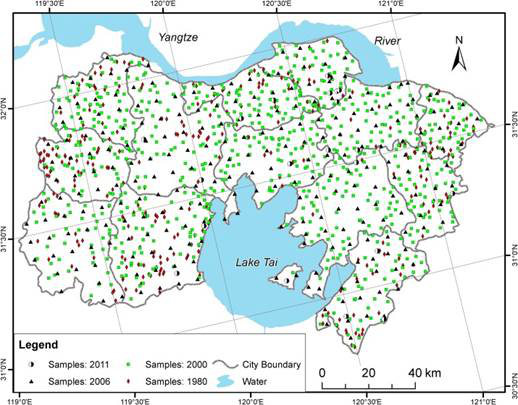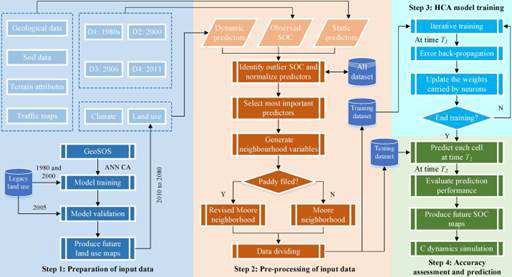土壤有機碳時空變異模擬研究取得進展


? ? ? ?
受限于土壤樣點的時間維屬性���,一般的土壤制圖只能獲得固定時間的“靜態(tài)”土壤圖��,描述目前或過去狀態(tài)的格局。但是����,土壤在不同土地利用條件下未來如何演變��,在不同的氣候變化情景下呈現(xiàn)怎樣的時空變化特征?這是土壤時空變化預測的重要主題���。
中國科學院南京土壤研究所張甘霖課題組副研究員宋效東以土地利用變化頻繁的太湖周邊地區(qū)為例�����,深入研究了土壤有機碳含量空間變異的主導因素���,提出了基于土壤發(fā)生理論的啟發(fā)式元胞自動機模型,模擬土壤有機碳含量在土地利用與氣候變化條件下未來60年內(nèi)的時空變異特征���。有別于常規(guī)的元胞自動機模型���,該方法不僅能夠有效集成影響土壤有機碳含量的靜態(tài)/動態(tài)環(huán)境變量,還能夠根據(jù)土地利用類型(旱地/水田)動態(tài)地度量有機碳富集對臨近區(qū)域有機碳水平遷移的影響范圍�。鑒于土地利用類型的重要性,根據(jù)歷史土地利用圖層制作了研究區(qū)未來60年的土地利用變化圖���。模擬結果表明:研究區(qū)土壤表層有機碳含量在未來60年內(nèi)隨著氣溫��、降雨的升高與城鎮(zhèn)化進程的推進將呈現(xiàn)持續(xù)上升的趨勢�����。研究提出的預測模型為土壤屬性的時空變異模擬提供了新的解決方案與思路�����。
該研究成果發(fā)表在Agriculture, Ecosystems and Environment上��。研究得到國家重點研發(fā)計劃(2017YFA0603002)���、科技基礎性工作專項(2008FY110600)��、國家自然科學基金(41571130051和41771251)的資助���。(來源:中國科學院南京土壤研究所)
?
Heuristic cellular automaton model for simulating soil organic carbon under land use and climate change: A case study in eastern China
?
Abstract??The concentration of soil organic carbon (SOC) is one of the most important soil properties, and its spatio-temporal variability greatly affects the global climate and agroecology. To investigate the effects of land use and climate change on SOC, a heuristic cellular automaton (HCA) model was proposed and applied to a plains area in eastern China with a high population density and rapid urbanization rate. The HCA model was designed to simulate the geographical variation in SOC dynamics over the long term (2080), and lateral carbon (C) migration is represented by revised neighbourhood variables at the macro scale. Three widely used soil mapping techniques were applied for comparison: multiple linear regression (MLR), support vector machine (SVM) and kriging with external drift (KED). The HCA model enhanced the accuracy of the predicted SOC by 15.27% over MLR, 12.31% over SVM and 10.98% over KED. Future land use maps were produced using legacy land use data and artificial neural network-based cellular automata (CA), and the simulation results showed the rapid urbanization of this area, where the percentage of cropland declined by 23.75% and that of village/urban areas increased by 22.90% from 2010 to 2080. The overall SOC concentrations are anticipated to increase by 2080 given the rising mean annual air temperature and mean annual precipitation. Our results also suggested that land use change clearly influenced the change in soil C, with village/urban areas exhibiting higher SOC than cropland. To provide stakeholders with accurate soil information, it is important to understand the comprehensive impacts of land use and climate change on soil evolution; this study illustrates the value of integrating pedogenetic information in soil C simulation models.